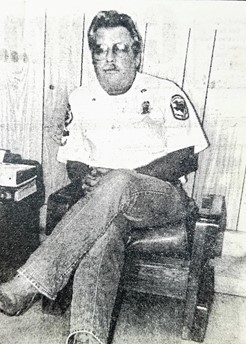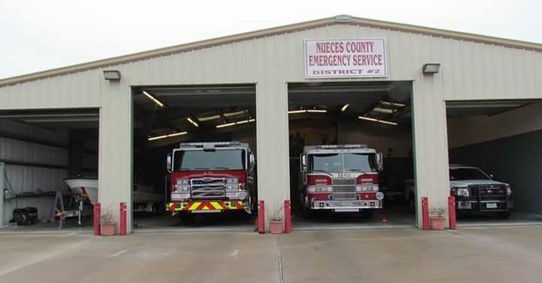To preserve the rich history of Flour Bluff, The Texas Shoreline News, will run historical pieces and personal accounts about the life and times of the people who have inhabited the Encinal Peninsula. Each edition will feature the stories gleaned from interviews held with people who remember what it was like to live and work in Flour Bluff in the old days. You won’t want to miss any of these amazing stories.
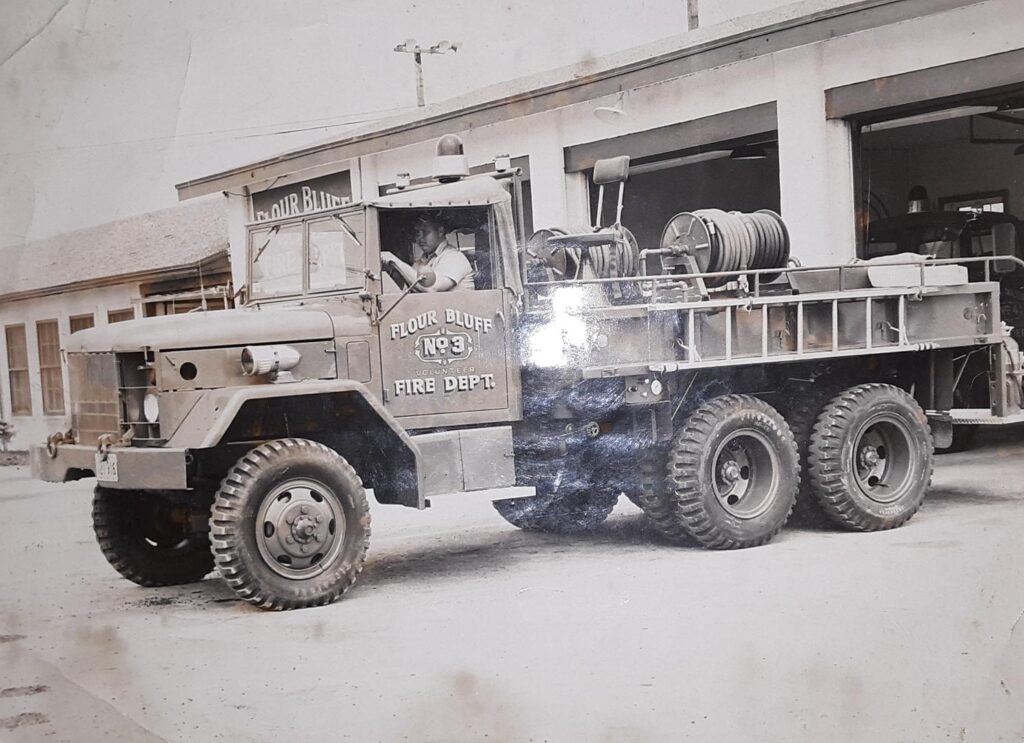
Unit 3 was a surplus army truck. John Crofton is the driver of this two-seater that would hold about 800 to 900 gallons of water. (Photo credit: John Crofton)
“When the fire department first started doing the parade it was very hard. We would spend several days putting the bags together and then freeze our a– off. But the smiles were worth every minute of it,” recalls John Crofton, a volunteer who would also play the role of Santa for many years starting in 1963. “I remember Pappy Preston having tears flowing down his face when we were able to give a young lady a chance to see and be held by Santa for the first time in her life at age 8. She had a medical condition that wouldn’t allow her to sit up or walk. She got a typewriter from Santa thanks to the members of the fire department and Billy Aldridge.”
This has always been the way of the members of the Flour Bluff Volunteer Fire Department (aka Nueces County ESD#2). These were men and women who made the decision to serve their community in any way they could. Sometimes it meant fighting a fire. Other times it meant lending a hand, watering trees planted by the
Getting its start in the early 1950s, the little fire department has had dozens of volunteers over the years, including a man named Jim Coffman, owner and operator of A&H Sporting Goods on the corner of Island Drive and Laguna Shores Road, where Wind and Wave is today. Coffman, a local businessman and community activist, joined the volunteers in its earliest days and became its president in 1959.
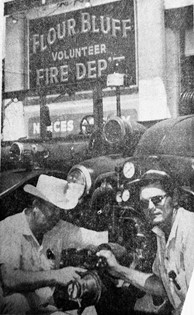
Chief Jim Coffman and mechanic Bill Mocherman work on a pump of one of the fire trucks. (Photo courtesy of Bernie Arnold collection)
“What is this, a woman driving a fire truck?” Coffman thought as a dinky little fire truck sped by his Sportsman’s Center on its way to a fire on Padre Island in 1950. That evening, Bill Cole, the secretary to the fire department dropped by and told Coffman that Flour Bluff was desperate for firemen. The women had to make many of the fires; there were only five men, and the truck was kept at Jay Essig’s house. Coffman joined the volunteers and served for 20 years, 10 of those as chief.
In 1959, the department possessed one truck capable of fighting fire, one partially completed, and no place to house them. Proper gear and training came at a cost to the volunteers. Fundraisers of all types were held over the years to support the department’s efforts. Barbecues, raffles, sales of plaques, monetary and material donations, and lots of physical labor kept the department alive.
On March 12, 1960, the voters of Flour Bluff went to the polls to vote on the formation of a Flour Bluff Fire District, which came with a 3-cent tax on each $100 property valuation to give the fire department a source of dependable revenue it had never had. The Kiwanis Club, Lions Club, American Legion, and Recreation Council of Flour Bluff, as well as all business owners in Flour Bluff all agreed it should happen. The Flour Bluff Taxpayers Association was opposed to it. They didn’t think that the tax revenue would be enough to support the department. The citizens voted. Out of 512 qualified voters, 349 voted for and 163 voted against the fire district. It was a record vote for Flour Bluff, one not equaled even by a National election.
The Nueces County Rural Fire Prevention District No. 2 was established. Jim Coffman became president; Bill Call, vice president; Virl W. Preston, secretary. The chief was Gene Davis. They started a fresh recruiting drive, which netted an active membership of 56 volunteers. On a piece of ground located on Laguna Shores Road near Davis Drive (now South Padre Island Drive), the new commissioners moved to build a firehouse and renovate the equipment – largely on faith.
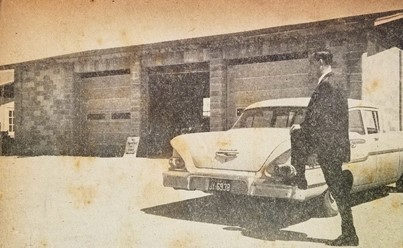
Virl W. Preston looks over the new firehouse on Laguna Shores Road built in 1960. This building, built by volunteer firemen in their spare time, would be used until 2004 when the new station opened on Yorktown. The building was razed in 2018 after sitting vacant for many years and becoming a draw for transients and homeless. (Photo courtesy of Bernie Arnold collection)
As they outlined their plans to various persons, donations of building materials, plumbing and electrical fixtures, parts for the trucks, labor, and money began to roll in, and the building began to go up. The Kiwanis Club voted to underwrite the cost of the sliding doors. Two months into the project, the 50 by 32-foot modern concrete block building with space for three fire trucks, an office, showers, and restroom facilities was nearly finished. Working in their spare time and on weekends, the firemen also took on the job of finishing a Flour Bluff community recreation building next door to the firehouse.
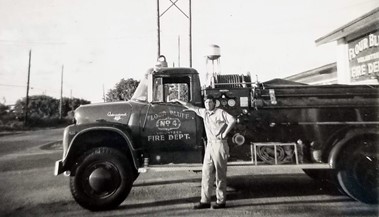
Jim Coffman, Jr. stands outside the Laguna Shores fire station. Note the water tower in the background. This tower served the Flour Bluff area until the new one was built near Flour Bluff Drive. (Photo courtesy of Bernie Arnold collection)
Civic pride is at the heart of what volunteer firefighters are. They continued to forge ahead helping the community in every way they could. In 1962, the Santa float made its debut delivering candy and smiles to the children of Flour Bluff. This tradition continues today and covers not only Flour Bluff but NAS and North Padre Island.
By 1963, notable progress had been made within the department thanks to the tax dollars and continued support from the community and businesses. In addition to the new firehouse and recreation hall, a second truck was added, and the commissioners acquired a retired Navy truck from the NAS Fire Department. However, they lost this truck in a raging brush fire that spread from a broken gas main. It was replaced soon after by a $12,000 truck purchased by donations and fundraising efforts carried on by department members for many months. A hose truck was added to the fleet along with other emergency equipment. All three trucks were pumpers and two were tankers capable of carrying up to 400 gallons of water. The volunteers bought used, two-way radio sets from various agencies for their personal cars so they could stay in touch with the department. And, Coffman, who had been fire chief in the Army at Ft. Crockett brought much needed knowledge and skills to the department.
The volunteers have come from every walk of life. Chief Jim Coffman, a businessman, had two assistant chiefs in 1963, Bill Cole, a science teacher at Flour Bluff, and Len Redding, a metalworker. Over the years, there have been teachers, bankers, insurance agents, tugboat captains, commercial fishermen, ranchers, and a host of others who volunteer to fight fires. Women have always played an active role both behind the scenes and on the front lines. Some do it for the thrill of battling a blaze, others for the comradery among the firefighters and their families, but most answer the call out of duty to their friends and neighbors in a time of need.
Over the years, many improvements were made in the way the volunteers fought fires. Ed Stoll, a Naval Air Station firefighter who became a Flour Bluff volunteer in 1961 (the year Flour Bluff was annexed by the city), told a Caller-Times reporter in 1986 that volunteers had to change with the times in order to be more effective at fighting fires. For example, he spoke of how firefighting technology and training had evolved to address the greater use of plastics as building materials and how firefighters needed to know what toxic gases can be released by the burning of such materials.
“Now, we’re more refined,” said Stoll. “We send ‘em to schools; we bring in instructors to teach; I teach some of the courses. It’s not a volunteer department where we sit around every Monday night.”
Stoll taught his crews about the elements of fire (fuel, oxygen, and heat), hose and water handling, the chemistry of burning, and all other aspects of the subject that a firefighter needs to know. The volunteers were no longer fighting fires in t-shirts and jeans; they were using proper protective gear. The science of firefighting was changing the way the FBVFD took care of business.
Today, the Nueces County ESD#2 looks a lot different with its new firehouse on Yorktown Boulevard and its shiny, red firetrucks, rescue boat, brush truck, and rescue boat. Chief Dale Scott and his crews work to provide the highest level of emergency response and fire prevention services to citizens of the Nueces County Emergency Services District # 2, which includes the City of Corpus Christi, areas outside city limits, Padre Island National Seashore, and unprotected areas of Kleberg and Nueces Counties. The 11 fulltime crews receive the same training as any other firefighter in the state and must have the same certification. They protect a resident population of over 36,000 and cover urban, suburban, and rural areas encompassing 80 square miles. They serve a diversified district composed of an extensive variety of family dwellings, homes on canals, industrial facilities, businesses, and commercial retail centers. Add to that a major highway system that crosses through the district and over 150 miles of waterfront.
Still the department has managed to retain that civic pride that is at the heart of a volunteer. The ESD#2 has paid firefighters, but it still uses volunteers, too, a 70-year-old tradition in the Flour Bluff community. Entire families are still “part” of the department. Some of the volunteers are third-generation firefighters. They work together to raise funds for good causes, such as the Santa float, volunteer at community events like Flour Fest and Community Christmas, teach fire safety to children in schools and daycares, and do as those who came before them did. The FBVFD/ESD#2 in its own way helps Flour Bluff retain its small-town feel even though it is part of a big city, and that has made all the difference. Hats off to the volunteers past and present!
_________________________________________________________________
The writer welcomes all corrections or additions to the stories to assist in creating a clearer picture of the past. Please contact the editor at [email protected] to submit a story about the early days of Flour Bluff.
